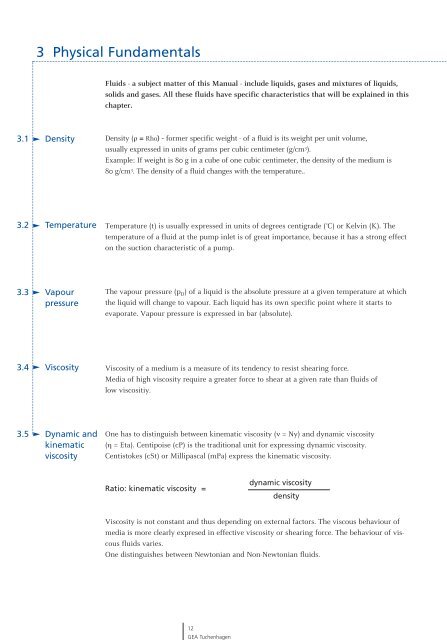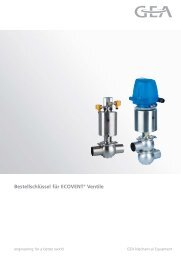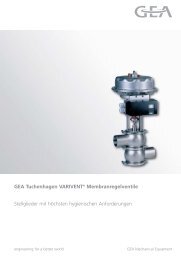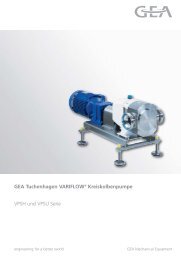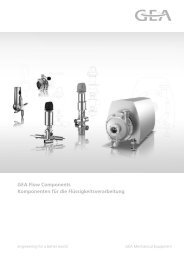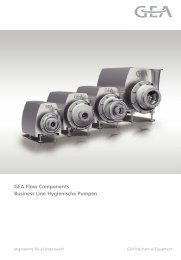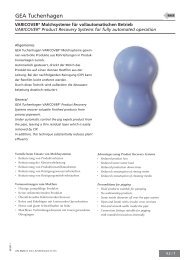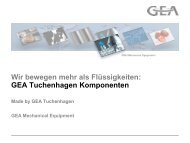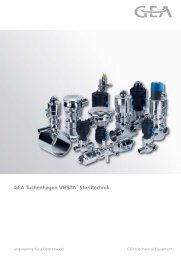Manual for the Design of Pipe Systems and Pumps - GEA ...
Manual for the Design of Pipe Systems and Pumps - GEA ...
Manual for the Design of Pipe Systems and Pumps - GEA ...
Create successful ePaper yourself
Turn your PDF publications into a flip-book with our unique Google optimized e-Paper software.
3 Physical Fundamentals<br />
3.1 Density<br />
3.2 Temperature<br />
3.3 Vapour<br />
pressure<br />
3.4 Viscosity<br />
3.5 Dynamic <strong>and</strong><br />
kinematic<br />
viscosity<br />
Fluids - a subject matter <strong>of</strong> this <strong>Manual</strong> - include liquids, gases <strong>and</strong> mixtures <strong>of</strong> liquids,<br />
solids <strong>and</strong> gases. All <strong>the</strong>se fluids have specific characteristics that will be explained in this<br />
chapter.<br />
Density (ρ = Rho) - <strong>for</strong>mer specific weight - <strong>of</strong> a fluid is its weight per unit volume,<br />
usually expressed in units <strong>of</strong> grams per cubic centimeter (g/cm 3 ).<br />
Example: If weight is 80 g in a cube <strong>of</strong> one cubic centimeter, <strong>the</strong> density <strong>of</strong> <strong>the</strong> medium is<br />
80 g/cm 3 . The density <strong>of</strong> a fluid changes with <strong>the</strong> temperature..<br />
Temperature (t) is usually expressed in units <strong>of</strong> degrees centigrade (°C) or Kelvin (K). The<br />
temperature <strong>of</strong> a fluid at <strong>the</strong> pump inlet is <strong>of</strong> great importance, because it has a strong effect<br />
on <strong>the</strong> suction characteristic <strong>of</strong> a pump.<br />
The vapour pressure (p D) <strong>of</strong> a liquid is <strong>the</strong> absolute pressure at a given temperature at which<br />
<strong>the</strong> liquid will change to vapour. Each liquid has its own specific point where it starts to<br />
evaporate. Vapour pressure is expressed in bar (absolute).<br />
Viscosity <strong>of</strong> a medium is a measure <strong>of</strong> its tendency to resist shearing <strong>for</strong>ce.<br />
Media <strong>of</strong> high viscosity require a greater <strong>for</strong>ce to shear at a given rate than fluids <strong>of</strong><br />
low viscositiy.<br />
One has to distinguish between kinematic viscosity (ν = Ny) <strong>and</strong> dynamic viscosity<br />
(η = Eta). Centipoise (cP) is <strong>the</strong> traditional unit <strong>for</strong> expressing dynamic viscosity.<br />
Centistokes (cSt) or Millipascal (mPa) express <strong>the</strong> kinematic viscosity.<br />
Ratio: kinematic viscosity =<br />
Viscosity is not constant <strong>and</strong> thus depending on external factors. The viscous behaviour <strong>of</strong><br />
media is more clearly expresed in effective viscosity or shearing <strong>for</strong>ce. The behaviour <strong>of</strong> viscous<br />
fluids varies.<br />
One distinguishes between Newtonian <strong>and</strong> Non-Newtonian fluids.<br />
12<br />
<strong>GEA</strong> Tuchenhagen<br />
dynamic viscosity<br />
density


